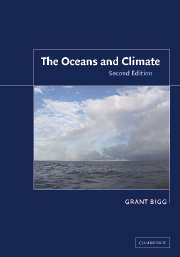Book contents
- Frontmatter
- Contents
- Preface to the first edition
- 1 The climate system
- 2 Physical interaction between the ocean and atmosphere
- 3 Chemical interaction of the atmosphere and ocean
- 4 Biogeochemical interaction of the atmosphere and ocean
- 5 Large-scale air–sea interaction
- 6 The ocean and natural climatic variability
- 7 The ocean and climatic change
- Appendices
- Glossary
- Bibliography
- Index
- References
4 - Biogeochemical interaction of the atmosphere and ocean
Published online by Cambridge University Press: 05 June 2012
- Frontmatter
- Contents
- Preface to the first edition
- 1 The climate system
- 2 Physical interaction between the ocean and atmosphere
- 3 Chemical interaction of the atmosphere and ocean
- 4 Biogeochemical interaction of the atmosphere and ocean
- 5 Large-scale air–sea interaction
- 6 The ocean and natural climatic variability
- 7 The ocean and climatic change
- Appendices
- Glossary
- Bibliography
- Index
- References
Summary
The oceans teem with life on all scales from microscopic plant and animal life to blue whales. Tiny plants known as phytoplankton form the base of the numerous intricate food chains. These organisms photosynthesize; they are therefore found in the surface layers of the ocean. Most biological activity in the ocean also occurs in this region, although marine organisms exist at all depths, including within the sediments on the sea floor. Phytoplankton, and other marine organisms, constitute a component of the carbon cycle (§ 3.3) and produce chemical compounds that ultimately influence the concentrations of particular atmospheric gases and aerosols. The influence of marine biology on climate, through such mechanisms, has only recently been appreciated; this chapter attempts to discuss the biological processes that may influence the climate, and assesses their importance.
Phytoplankton
Plankton are defined as living organisms within the sea which are essentially restricted to moving with the prevailing current; they are not, however, completely devoid of motility, as some species swim upwards towards stronger light conditions during daylight hours while others move deeper to regions of lower intensity. Phytoplankton are plant species within this category of organisms. They are so called because they photosynthesize – hence ‘phyto'plankton. Commonly, there are a large number of different species within any one population. Differences in species’ biological behaviour can be important in discussions of population dynamics, and will appear in § § 4.3 and 4.4 when we discuss chemicals produced by plankton that influence the climate, but in this general description they will usually be ignored.
- Type
- Chapter
- Information
- The Oceans and Climate , pp. 122 - 140Publisher: Cambridge University PressPrint publication year: 2003



